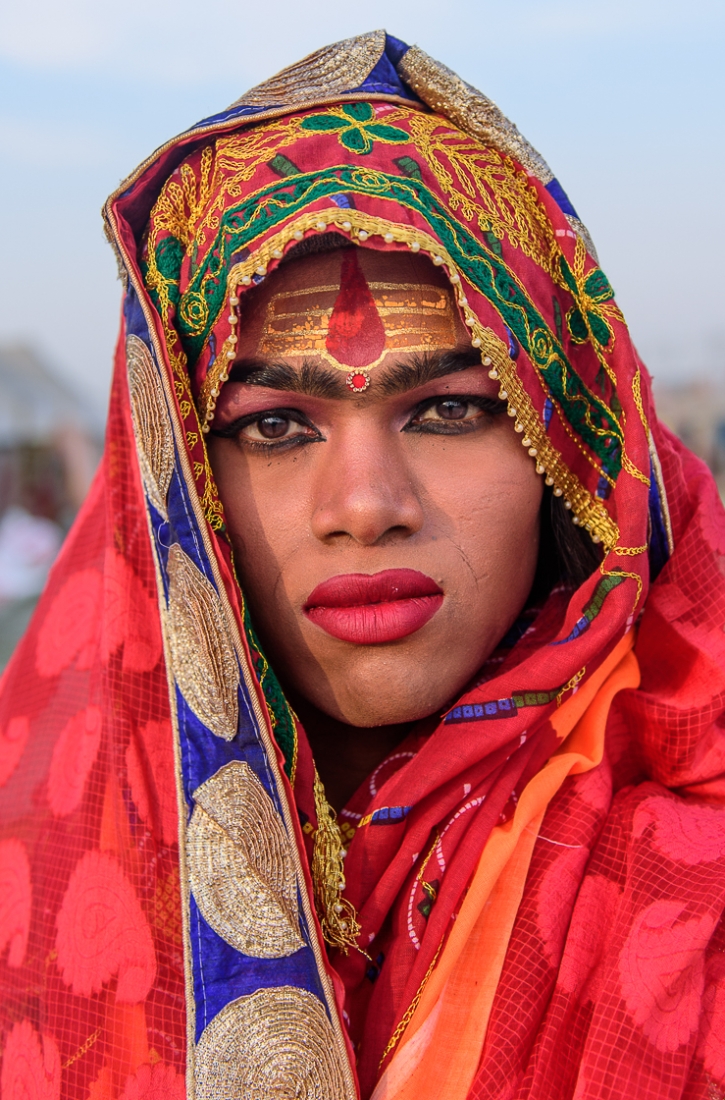honorable mention
Shantanu Saha united states
Photo © Shantanu Saha
title
From Pariah to Demigods: How Kumbh Mela 2019 is Redefining an Entire Community
Ancient Hindu scriptures described hijras as people with the powers to confer blessings during auspicious occasions, hence many hijras sustain themselves by seeking alms in exchange for showering blessings during rituals. Mythology also refers to transgenders as Kinnars: creatures who excel in singing and dancing and this is the preferred identity for the hijra community in India.
With the establishment of the Kinnar akhada (monastic order) during the 2019 Kumbh Mela, the founder and globally-renowned trans activist Laxmi Narayan Tripathy seeks to build a harmonious and inclusive space for the transgenders under a spiritual umbrella.
The holy bath at Kumbh Mela is traditionally initiated by the male akhada members. Akhadas can be loosely interpreted to be monastic orders under the Hindu religious umbrella; what sets Kinnar Akhada apart is its syncretic nature, there are monastics of many faiths participating in this akhada. This is the 14th akhada and the only one with non-male members to be in the grounds during Kumbh Mela.
One of the prime purposes of the Kinnar akhada is to provide a new face to the trans identity in India, one beyond the confines of sexuality and one that allows them to explore roles and activities beyond the traditional ones.
He recently covered the world's largest human congregation called the Kumbh Mela in Prayagraj for The Times of India. His works has been featured by National Geographic, Discovery Digital Network, Religion News Service, South China Morning Post, The Telegraph etc.
He lives to tell the human story.
back to gallery
entry description
Transgender people in India gained official recognition as a third gender in 2014. Social acceptance and inclusion, however, do not automatically accompany a legal ruling. Transgenders or "hijras" as they are called in the Indian subcontinent find it hard to find main-stream work and are often boxed into roles purely defined by their sexual identity. Many are forced to carve a livelihood out of sex work or begging.Ancient Hindu scriptures described hijras as people with the powers to confer blessings during auspicious occasions, hence many hijras sustain themselves by seeking alms in exchange for showering blessings during rituals. Mythology also refers to transgenders as Kinnars: creatures who excel in singing and dancing and this is the preferred identity for the hijra community in India.
With the establishment of the Kinnar akhada (monastic order) during the 2019 Kumbh Mela, the founder and globally-renowned trans activist Laxmi Narayan Tripathy seeks to build a harmonious and inclusive space for the transgenders under a spiritual umbrella.
The holy bath at Kumbh Mela is traditionally initiated by the male akhada members. Akhadas can be loosely interpreted to be monastic orders under the Hindu religious umbrella; what sets Kinnar Akhada apart is its syncretic nature, there are monastics of many faiths participating in this akhada. This is the 14th akhada and the only one with non-male members to be in the grounds during Kumbh Mela.
One of the prime purposes of the Kinnar akhada is to provide a new face to the trans identity in India, one beyond the confines of sexuality and one that allows them to explore roles and activities beyond the traditional ones.
about the photographer
Shantanu Saha is a freelance photojournalist curently based in Philadelphia, USA. Originally from the City of Joy, Kolkata, Shantanu nurtured his photography skills in the vibrant and chaotic streets of Kolkata and Varanasi. He started off with street photography and gradually developed an interest in visual storytelling. He pivoted to travel documentary photography but ultimately fell in love with photojournalism. Over the course of the last decade, photography has taken him to ancient Hindu priest schools and the traditional wrestling gyms of Varanasi, Buddhist monasteries in the Himalayas, the tango milongas of Buenos Aires, ancient colonial interiors of Mexico, the Rohingya refugee camps of Bangladesh, the headhunting insurgent tribal villages of Nagaland, the colorful lanes of Barsana and Nandgaon during Lathmaar Holi, the Super Bowl celebrations in the streets of Philly, the Times Square on New Year's Eve.He recently covered the world's largest human congregation called the Kumbh Mela in Prayagraj for The Times of India. His works has been featured by National Geographic, Discovery Digital Network, Religion News Service, South China Morning Post, The Telegraph etc.
He lives to tell the human story.
back to gallery

